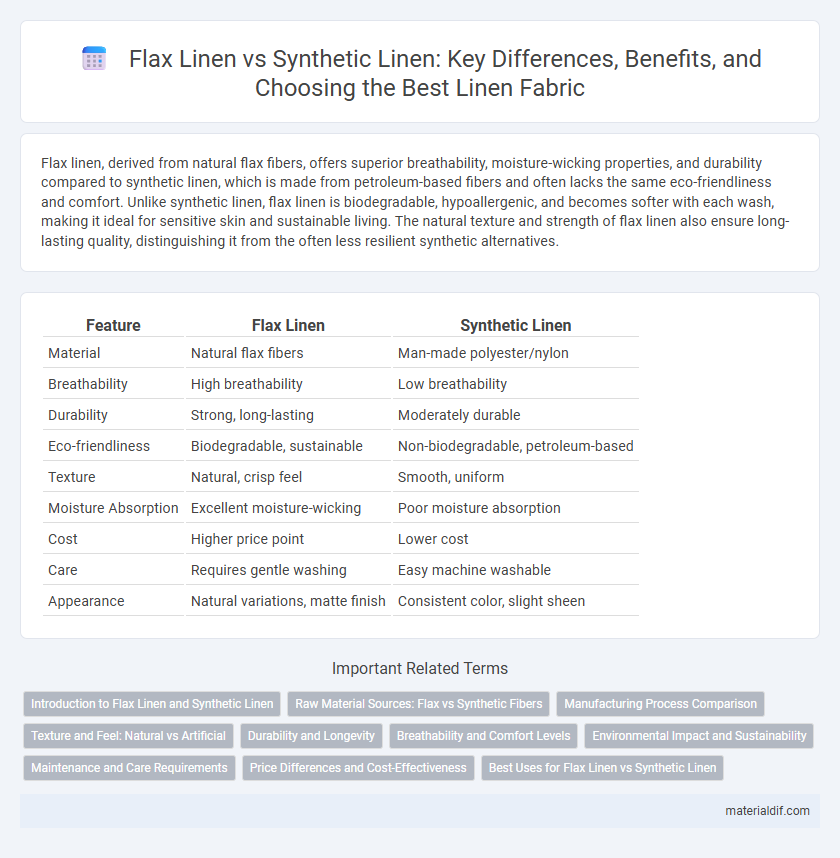Flax linen, derived from natural flax fibers, offers superior breathability, moisture-wicking properties, and durability compared to synthetic linen, which is made from petroleum-based fibers and often lacks the same eco-friendliness and comfort. Unlike synthetic linen, flax linen is biodegradable, hypoallergenic, and becomes softer with each wash, making it ideal for sensitive skin and sustainable living. The natural texture and strength of flax linen also ensure long-lasting quality, distinguishing it from the often less resilient synthetic alternatives.
Table of Comparison
| Feature | Flax Linen | Synthetic Linen |
|---|---|---|
| Material | Natural flax fibers | Man-made polyester/nylon |
| Breathability | High breathability | Low breathability |
| Durability | Strong, long-lasting | Moderately durable |
| Eco-friendliness | Biodegradable, sustainable | Non-biodegradable, petroleum-based |
| Texture | Natural, crisp feel | Smooth, uniform |
| Moisture Absorption | Excellent moisture-wicking | Poor moisture absorption |
| Cost | Higher price point | Lower cost |
| Care | Requires gentle washing | Easy machine washable |
| Appearance | Natural variations, matte finish | Consistent color, slight sheen |
Introduction to Flax Linen and Synthetic Linen
Flax linen, derived from the fibers of the flax plant, is celebrated for its natural breathability, durability, and eco-friendly qualities, making it an ideal choice for sustainable textiles. Synthetic linen, typically made from polyester or rayon, offers increased wrinkle resistance and lower cost but lacks the biodegradability and moisture-wicking properties found in flax linen. Understanding the differences in fiber origin, texture, and environmental impact is crucial when choosing between flax and synthetic linen for clothing or home textiles.
Raw Material Sources: Flax vs Synthetic Fibers
Flax linen originates from the natural fibers of the flax plant, derived through a sustainable harvesting and retting process, making it biodegradable and eco-friendly. Synthetic linen is manufactured from petroleum-based fibers such as polyester or nylon, relying on non-renewable resources and involving energy-intensive production methods. The raw material source fundamentally affects the environmental impact, durability, moisture-wicking ability, and breathability of the final linen fabric.
Manufacturing Process Comparison
Flax linen is produced through a natural process involving the harvesting of flax plants, retting to separate fibers, and mechanical or chemical treatment to obtain long, durable fibers. Synthetic linen, typically made from polyester or other man-made polymers, is manufactured through chemical synthesis and extrusion of fibers into filaments. The eco-friendly and labor-intensive process of flax linen contrasts with the energy-intensive, petroleum-based manufacturing of synthetic linen.
Texture and Feel: Natural vs Artificial
Flax linen offers a distinctively crisp and breathable texture with a natural softness that enhances comfort, while synthetic linen often mimics this feel but lacks the authentic breathability and cool touch of genuine flax fibers. The natural irregularities in flax linen create a unique tactile experience and improved moisture-wicking properties, whereas synthetic variants tend to feel smoother but can trap heat and moisture. Choosing flax linen ensures a tactile richness and durability derived from its natural origins, contrasted with synthetic linen's uniform texture and potential for less comfort over time.
Durability and Longevity
Flax linen, derived from the flax plant, is renowned for its exceptional durability and natural strength, outperforming synthetic linen in wear resistance and breathability. Unlike synthetic fibers, flax linen improves in softness over time while maintaining its structural integrity, making it a long-lasting fabric ideal for everyday use. Synthetic linen, often made from polyester or rayon blends, tends to degrade faster under repeated washing and exposure to sunlight, reducing its lifespan compared to authentic flax linen.
Breathability and Comfort Levels
Flax linen, derived from natural flax fibers, offers superior breathability and moisture-wicking properties compared to synthetic linen, making it ideal for warm climates and sensitive skin. The natural fiber structure allows airflow, reducing heat buildup and enhancing comfort throughout the day. Synthetic linen, often made from polyester blends, tends to trap heat and moisture, resulting in reduced breathability and less comfort for prolonged wear.
Environmental Impact and Sustainability
Flax linen, derived from the flax plant, boasts superior environmental benefits due to its biodegradability and low water consumption compared to synthetic linen, which is typically made from petroleum-based fibers and contributes to microplastic pollution. The cultivation of flax requires fewer pesticides and fertilizers, making flax linen a more sustainable choice with a lower carbon footprint than synthetic alternatives. Unlike synthetic linen that persists in landfills, flax linen decomposes naturally, enhancing its eco-friendly profile in textile production.
Maintenance and Care Requirements
Flax linen, derived from natural flax fibers, requires gentle washing in cool water and air drying to maintain its breathable texture and durability. Synthetic linen, made from polyester or blends, is more resistant to wrinkling and stains, allowing for easier machine washing and quicker drying without special care. Proper maintenance of flax linen extends its lifespan while synthetic linen offers low-maintenance convenience suitable for everyday use.
Price Differences and Cost-Effectiveness
Flax linen typically costs significantly more than synthetic linen due to its natural fiber sourcing and labor-intensive production process. While synthetic linen offers affordable pricing and easy maintenance, flax linen provides superior durability and breathability, which contributes to long-term cost-effectiveness. Investing in flax linen often results in greater value over time despite the higher initial price.
Best Uses for Flax Linen vs Synthetic Linen
Flax linen, derived from natural flax fibers, offers superior breathability, durability, and moisture-wicking properties, making it ideal for summer clothing, upholstery, and eco-friendly home textiles. Synthetic linen, often composed of polyester blends, excels in affordability, stain resistance, and wrinkle-free maintenance, suitable for budget-friendly fashion and low-maintenance household items. Choosing flax linen supports sustainable practices and comfort, while synthetic linen caters to practical needs with enhanced durability and ease of care.
Flax Linen vs Synthetic Linen Infographic

 materialdif.com
materialdif.com